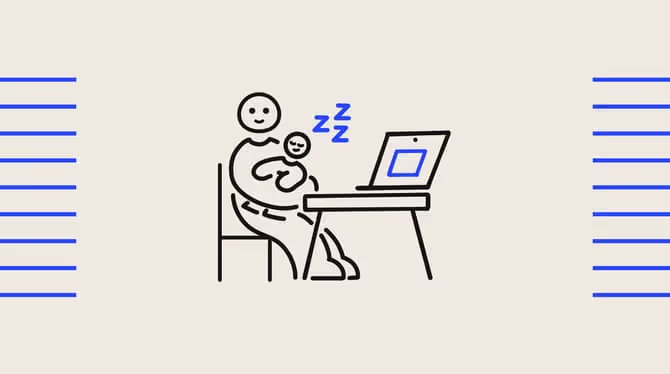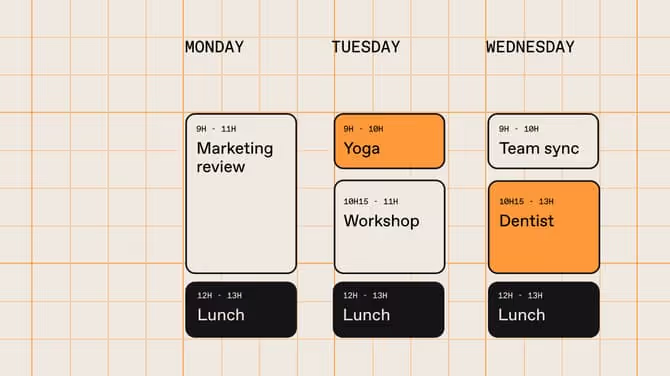A comprehensive guide to workplace flexibility

From flawed to flawless: 5 steps to leading distributed teams

Traditionally, managers relied on timesheets and 9-to-5 office attendance to validate how hard their employees were working. Sure, these measures ensure employees physically show up to work — but the fact is, none of these tactics are true indicators of performance.
In fact, 45% of tech workers across major companies like Amazon, Microsoft, Google, and Meta report doing most of their work within a 4-hour timeframe. This tells us that performance quality is not dependent on time spent at work.
In an era where the world is recognizing that everyone works differently and the rules of work have been redefined, how can managers ensure their teams are thriving and productive?
Enter the concept of a flexible workplace.
What is workplace flexibility?
Workplace flexibility encompasses an employer's approach to work that accommodates their employees' different needs to ensure they can thrive. A flexible mindset embraces the idea that, while everyone works differently and has a different interpretation of work-life balance, all employees can be productive — provided the right conditions.
In practice, workplace flexibility can refer to specific types of flexible workplace practices, including:
- Flexible scheduling
- Flexible hours
- Flexible PTO
- Flexible workspace
- Flexible responsibilities
- Flexible management
The below sections describe each in more detail.
Ultimately, workplace flexibility represents a non-traditional work structure, where companies provide the right support and environment to get the best possible output from their employees.
Flexible work hours
Flexible work hours mean employees have the freedom to choose their hours (or, at least, have some say in the hours they work). Instead of requiring employees to clock in at the standard 9 AM and clock out at 5 PM, they have a say in their own work hours. For employees working in-office, this can help them avoid a busy commute to maximize their day. For remote workers, this can help them make the most of peak mental productivity moments.
{emphasize}Breaking up the work day into segments: Say an employee has 7 hours of work to complete in a day, but has a dentist appointment in the morning. A flexible hours policy could allow them to start earlier, pause work to attend their appointment, resume in the afternoon, and work slightly later to finish their tasks.{emphasize}
Flexible scheduling
Work flexibility means accommodating worker needs when it comes to the days they work as well as the days they take off. This might be offering part-time work or the option for a compressed workweek that deviates from the typical 9-to-5, such as a 4-day workweek. It's not for everyone, but some employees get more done in a shorter (but more intense) sprint.
{emphasize}Consider Parkinson's Law: A psychological fact to hack, Parkinson’s Law claims that work expands to fill the time allotted for it. In other words, employees adjust their productivity to meet deadlines — which means that, ironically, more time to do a task can decrease productivity. As they say, there's no motivator like being on a time crunch!{emphasize}
Flexible PTO
Unlimited paid time off (PTO) is a policy that doesn’t limit the number of vacation days an employee can take. However (and paradoxically), an arbitrary number of days off might feel less freeing than a fixed number, as employees may view time off as elective — feeling guilty and pressured to take less time off than they need.
{emphasize}Set a minimum days-off requirement: To counter this paradox, some companies offer flexible PTO with a set minimum of days each employee should take off. This is a great way to implement the policy while ensuring no one overworks.{emphasize}
Flexible workspace
Flexible workspace, or flexible location, looks at flexibility in terms of where employees physically work. Remote work and distributed work are perhaps the two most common forms of workplace flexibility today, having become the norm after the pandemic. Colocated offices are another form of workspace flexibility, where teams rotate coming into a smaller, shared office on certain days — a strategy that can help companies decrease office space overhead costs!
{emphasize}Out of office, more focus (maybe): German Think Tank research shows that employees are interrupted at work an average of 15 times per hour — which is once every 4 minutes. The loss of productivity resulting from interruptions is estimated to cost companies about $63 billion per year globally. Yikes!{emphasize}
Flexible responsibilities
Today, it's not uncommon for employees to wear many hats. That said, workplace flexibility regarding job responsibilities (also referred to as job sharing) describes a fluid job structure where employees can take on different roles and tasks as needed, fostering a more dynamic and versatile work environment.
{emphasize}Job rotation programs: Implementing job rotation programs can help employees develop new skills and keep their work engaging. It's a strategy that enhances individual growth and increases the team's overall capability by ensuring more team members are cross-trained in various roles.{emphasize}
Flexible management
Integral to performance management, flexible management involves adapting leadership styles and management strategies to meet the needs of a flexible workforce. This can include adjusting communication methods, providing more autonomy to employees, and fostering a culture of trust and accountability — but more on that further down in this article.
{emphasize}Personalized support: Managers can tailor their approach to individual team members by understanding their unique working styles and preferences. Regular check-ins and adapting feedback delivery to suit each employee's needs can ensure everyone feels supported and valued.{emphasize}
Why implement workplace flexibility
More and more organizations are moving ahead with flexible policies for their workforces — but it's more than just jumping on the trend. So, why should managers care about workplace flexibility? Flexible work schemes can be incredibly beneficial at a company, team, and individual level.
The benefits of workplace flexibility
Flexible work policies, in all their possible combinations, have as an objective to provide a work environment conducive to employee satisfaction. They increase productivity, empower employees, and cater to personal needs for more inclusivity.
Boosts employee productivity
Location flexibility saves workers time on a long commute and helps remove the distractions of a colocated office. Flexibility in working hours can help workers find and take advantage of their moments of peak focus and creativity. Work-life flexibility allows employees to attend to and juggle personal life priorities in a more balanced way. All of these things funnel back toward improved productivity.
{highlight}An Owl Labs survey shows that WFH could be the key to happiness at work. Employees allowed to work from home (even just one day a month) showed a 24% job satisfaction increase compared to those who don't have that option. And the more employees are satisfied at work, the better they perform.{highlight}
Enhances autonomy and employee retention
Allowing employees to work when and where they can best focus improves efficiency and engagement. It also demonstrates trust from managers, which empowers employees to be more autonomous and personally accountable. All of this has tangible benefits for employee retention and reduced employee turnover.
{highlight}A Gallup study examined different working requirements across 16,000 flexible employees. 61% reported performing their tasks independently and then bringing their work to the team for collaboration. This proves that working outside the normal office structure doesn't hinder most core tasks!{highlight}
Allows for diversity, equity, and inclusivity to shine
Workplace flexibility shares the same principles as diversity, equity, and inclusion (DEI) — honoring the diverse needs of individuals within the same workforce. In direct correlation with each other, flexible work and DEI policies proactively help employees achieve their potential by curating the right environment. For instance, an employee with social anxiety can work remotely to avoid a people-packed commute, allowing them to show up to their day stress-free and focused.
{highlight}An Ernst & Young survey reveals that flexibility practices help increase the sense of belonging at work —where 45% of flexible employees feel that policies that enable autonomy in choosing hours and location relate to diversity, equity, and inclusion (DEI) within their own teams.{highlight}
The disadvantages of an inflexible workplace
Yes, the traditional 9-to-5 work structure has been the norm for decades. But maintaining an inflexible workplace comes with several drawbacks that can impact both employees and organizations negatively:
- Reduced employee morale and engagement: When employees feel constrained by rigid schedules and lack the freedom to balance their personal and professional lives, it can result in decreased job satisfaction and engagement.
- Increased burnout and stress: Without the ability to adjust work hours or work from different locations, employees may struggle to manage their workloads effectively — leading to increased stress levels and burnout.
- Limited talent pool: An inflexible workplace can limit an organization's ability to attract top talent. Millenial and Gen Z workers prioritize work-life balance and flexibility when choosing an employer.
- Higher turnover: A lack of flexibility can actually send employees job hunting: 30% of employees said they left a job (and 16% said they were looking for a new job) because of the lack of workplace flexibility.
- Lower productivity: Some people are more productive in the early morning, while others may do their best work in the evening. Rigid work schedules do not always align with employees' peak productivity periods.
- Decreased innovation and creativity: Employees who feel micromanaged or restricted by stringent policies are less likely to experiment, take risks, or think outside the box. Flexibility can foster a more dynamic and innovative workplace culture.
- Poor work-life balance: A lack of flexibility can make it difficult for employees to manage their personal responsibilities alongside their work commitments — affecting not only the employees' well-being but also their performance at work.
The old adage says, "If it ain't broke, don't fix it". But if work life (and productivity) can be improved through the implementation of formal flexibility policies, why not?
The key ingredients to making workplace flexibility work
Just like you can't make an omelet without cracking a few eggs, managers need to crack the code of trust and communication for workplace flexibility to succeed.
Without trust, managers may resort to micromanagement, which can stifle the benefits of flexible work arrangements. It's important to remember that employees often step into success when they're given the opportunity to.
Clear communication is equally important. Setting expectations, providing regular feedback, and creating a culture of open dialogue between managers and employees ensures everyone is on the same page.
3 steps to implementing flexibility strategies that work
It's all about measuring the success of your workplace flexibility strategies and adapting them based on needs. To implement flexibility in the workplace smoothly (and successfully), managers should follow these three steps:
Step 1. Observe current flexible working conditions
Before implementing flexible work policies, assess your team’s situation and what's available to them. Connect with other members of leadership to get a sense of how people work in different departments. Consider what might make sense (or not) for your team.
{emphasize}Ask questions like: Do employees work and collaborate from different time zones or locations? How many are parents with family constraints? Is mental health support considered in work-life balance right now?{emphasize}
Step 2. Introduce new flexible working strategies
Once you've established the gaps and opportunities for flexibility, it's time to test them out. When introducing new policies or options, managers should consider three key factors:
- Think about the structures you'll retain: For example, teams that work remotely on different schedules will often maintain an overlap in which all the members are working synchronously.
- Encourage trust instead of micromanagement: For workplace flexibility to work, you'll have to give some power to employees, trusting they won't take advantage of new freedom.
- Remember that policy is not practice: Create an environment where employees feel safe taking advantage of this flexibility without fear of repercussions for their careers or salaries.
Step 3. Evaluate performance (and adapt)
Sometimes, a new flexibility might seem like a great idea in theory but creates more harm than good in the long run. That's part of the process! Remain open to receiving feedback and finding possible unintended consequences to adjust. If a particular approach to workplace flexibility isn’t working for your team, change it. And if it does, embrace it.
4 tips for workplace flexibility
Creating flexible workplaces doesn't have to be complicated — although find additional tips below to ensure you're doing everything you can for a smooth rollout and sustained success.
Tip #1: Setting clear expectations
As a manager, establishing guidelines and communicating effectively ensures everyone is on the same page about policy objectives and meeting success standards.
{highlight}For instance, with flexible schedules, define the core hours when everyone should be available and clarify expectations for response times to emails and messages outside of that.{highlight}
Tip #2: Using tech and tools that are essential for remote collaboration
So many new tools are available — so leverage technology to facilitate things like remote work. Managers should also work with HR to see how employees can be empowered to manage their schedules, such as requesting time off.
{highlight}Tools like Slack, Zoom, and performance management software can help maintain communication and collaboration across locations and time zones.{highlight}
Tip #3: Developing strategies for building trust and accountability
Create management strategies around implementation to build trust and accountability. Regular check-ins, transparent communication, listening to and applying employee feedback, and clear goal-setting are all ways that foster a culture of trust.
{highlight}Holding weekly one-on-one meetings to discuss progress and address concerns demonstrates that a manager cares about employee satisfaction and the impact of flexible workplace policies on their team's happiness.{highlight}
Tip #4: Co-create what a flexible environment looks like
Involve employees in the creation of flexible work policies. This ensures that the policies meet their needs and encourages buy-in. How? Invite them to the conversation from the get-go and collect their honest feedback through confidential one-on-ones and Pulse Surveys to inform new strategies.
{highlight}If an internal survey reveals that most team members would rather have the option to work shorter weeks but longer days, this could inform the creation of an optional 4-day week policy.{highlight}
What about wellness in the workplace?
Workplace wellness is a critical component of a flexible work environment. Implementing flexible work policies can significantly contribute to employees' overall well-being.
Here are ways managers can factor in wellness when developing flexible arrangements:
- Physical health: Flexible work arrangements can improve employees' physical health by allowing them more time to exercise, prepare healthy meals, and get adequate rest.
- Mental health: Flexibility in the workplace can enhance employees' mental health. By allowing employees to choose their work hours and location, they can create a work environment that reduces stress and anxiety.
- Work-life balance: By providing options such as remote work, flexible hours, and compressed workweeks, employees can achieve better work-life balance — juggling their professional responsibilities with personal commitments.
- Social connectivity: While remote work can sometimes lead to feelings of isolation, fostering social connections within the team is essential. Virtual team-building activities, regular video check-ins, and social channels for informal interactions can help maintain a sense of community and support among remote or hybrid employees.
- Access to support and resources: Employers can provide mental health counseling, stress management workshops, and wellness apps. Other ideas include encouraging employees to take regular breaks, providing ergonomic office equipment, and promoting mindfulness practices.
- Creating a culture of well-being: A truly flexible workplace recognizes (and addresses) the unique needs of employees, promotes open communication, and encourages healthy work-life integration. Leadership should model wellness behaviors themselves to help shape a positive and healthy work environment.
By fusing wellness considerations with a flexible mindset, managers can create a supportive environment where employees feel valued, engaged, and motivated to show up as their best selves every day.
Workplace Flexibility: The Future of Team Management
Don't fear flexibility for your team, embrace it. A little bit of leeway can go a long way — and the most productive and high-performing teams have a healthy dose of trust and flexibility. So be open and get creative to find ways to keep employees happy and in charge of their workloads, and watch your team thrive.
Making a flexible workplace work with Workleap
Leverage the tools, guides, and ebook found in our resource library to further inspire you in creating a flexible and productive work environment that aligns with your company and team's values. There's no one-size-fits-all, but there is a general framework of success for employee engagement and productivity — and in a digital world
Give HR and managers the clarity, confidence, and connection to lead better every day.


%20(1).avif)


.avif)
.avif)








